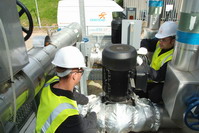 The imperative in industry to cut energy costs and reduce green house gases is good news for suppliers of high efficiency motors. However, the projected efficiency gains from using EFF1 or 2 type machines will not be achieved if motor system and supply problems that existed before they were installed are not resolved. One of the most common of these is low power factor.
The imperative in industry to cut energy costs and reduce green house gases is good news for suppliers of high efficiency motors. However, the projected efficiency gains from using EFF1 or 2 type machines will not be achieved if motor system and supply problems that existed before they were installed are not resolved. One of the most common of these is low power factor. Motors operated with low power factors are expensive and inefficient. In the worst cases this can result in utility supply companies having to increase their generation and transmission capacity to handle the reactive power component caused by inductive loads. There is a price for this: in the UK, the threshold value for power factor is 0.85, below this figure industrial users are generally charged more by their suppliers. In view of this, and because low power factor also reduces the distribution capacity of an electrical system - increasing current flow and causing voltage drops - companies need to be aware of the problem and the measures they need to take to overcome it.
Unfortunately, the general understanding of power factor, and the relationship between the elements that comprise it, can often be vague. A very simple analogy can address this. The analogy concerns a barge being towed along a canal by a tractor. The tractor cannot pull the load directly from the front for obvious reasons; the effort coming instead from the side. The effort required to move the barge down the canal is the working (real) power; and that of the tractor, the total or apparent power. Now, because of the angle of the tractor’s pull, not all of the effort is used to move the barge down the canal. The restraining sides of the canal mean that the barge will not move sideways; therefore, the sideways pull of the tractor is wasted effort or nonworking (reactive) power.
All this is relevant because the angle of the tractor pull is related to power factor, which is defined as the ratio of real (working) power to apparent (total) power. If the angle of pull decreases, then the real power approaches the value of the apparent power. With this convergence, the ratio of real power to apparent power (the power factor) approaches 1 – which is the ideal - and the reactive (nonworking) power reduces towards zero.
Low power factor is caused by inductive loads such as transformers and electric motors, which are a major portion of the power consumed in industrial complexes. Unlike resistive loads that create heat by consuming kilowatts, inductive loads require the current to create a magnetic field, and the magnetic field produces the desired output. The total or apparent power required by an inductive device is a composite of Real power, measured in kW, and Reactive power, caused by the magnetizing current required to operate the device, which is (measured in kilovars, kVAR. An increase in reactive power increases the amount of apparent power (measured in kilovolt amps, kVA) in a distribution system, and this causes a decrease in power factor.
For two systems transmitting the same amount of real power, the system with the lower power factor will have higher circulating currents due to energy that returns to the source from energy storage in the load. These higher currents in a practical system may produce higher losses and reduce overall transmission efficiency. A lower power factor circuit will have a higher apparent power and higher losses for the same amount of real power transfer.
There are a number of measures that can be employed to improve power factor. First, users should minimise the operation of idling or lightly loaded motors. Second, operation of equipment above its rated voltage should be avoided. Third, capacitors should be installed in motor circuits to decrease the magnitude of reactive power. Fourth and final, standard motors should be replaced as they wear out with energy-efficient motors. However, here it must be said that even with energy-efficient motors, power factor is significantly affected by variations in load. Consequently, motors must be operated near their rated capacity to realise the benefits of a high power factor design.
The benefits of undertaking these measures are many - a much reduced utility bill for a start. Moreover, with a corrected power factor losses in the distribution system are largely overcome, providing increased capacity for other loads to be connected. The optimised power factor also means that excessive voltage drops, which can cause overheating and premature failure of motors, are avoided leading to extended equipment life. Finally there is the major environmental benefit: reduced power consumption means less CO2 emissions entering the atmosphere, helping to reduce the carbon footprint of industry generally.
About Deritend Industries
Deritend Industries offers wide experience of energy saving with electric motors, and specialises in all aspects of motor replacement; from condition monitoring to conducting motor usage surveys, supplying motors off the shelf to repairing motors of any type or size, to installing/maintaining the units and providing impartial advice in all these areas.

